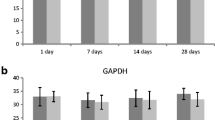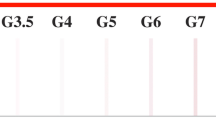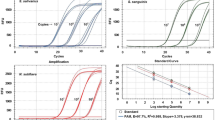Abstract
Forensic investigations in dog attacks usually involve the examination of bite marks and toothprints, the dog’s stomach and pathological methods. For identification of the offending dog we evaluated canine STR typing of saliva traces on dog bite marks. The specificity of 15 canine-specific STRs was tested on human-canine DNA mixtures prior to an applied study in which 52 cases of dog bites were investigated. The first-aid wound bandages as well as swab samples from the surrounding area of the wound were used for DNA analyses. Generally, it was possible to obtain a canine-specific STR profile from the dog’s saliva left on the wound area, even when high background of human DNA was present (blood). Interestingly, we found canine STR typing to be more successful when the bandages and swabs showed high amounts of human blood, i.e. when the dog bite was severe. Canine saliva was then sometimes visible as white-coloured secretion on the human blood surface. Less severe bite cases, which did not result in bleeding wounds, showed less success in obtaining useful STR results, probably due to the fact that the surface of the wounds may have been treated before the victims consulted medical aid which therefore removed the canine cells.




Similar content being viewed by others
References
Overall KL, Love M (2001) Dog bites to humans—demography, epidemiology, injury, and risk. J Am Vet Med Assoc 218:1923–1934
De Munnynck K, Van de Voorde W (2002) Forensic approach of fatal dog attacks: a case report and literature review. Int J Legal Med 116:295–300
Ozanne-Smith J, Ashby K, Stathakis VZ (2001) Dog bite and injury prevention—analysis, critical review, and research agenda. Inj Prev 7:321–326
Brogan TV, Bratton SL, Dowd MD, Hegenbarth MA (1995) Severe dog bites in children. Pediatrics 96:947–950
Gershman KA, Sacks JJ, Wright JC (1994) Which dogs bite? A case-control study of risk factors. Pediatrics 93:913–917
Anon (2003) Nonfatal dog bite-related injuries treated in hospital emergency departments-United States, 2001. MMWR Morb Mortal Wkly Rep 52:605–610
Sacks JJ, Sattin RW, Bonzo SE (1989) Dog bite-related fatalities from 1979 through 1988. JAMA 262:1489–1492
Sacks JJ, Kresnow M, Houston B (1996) Dog bites: how big a problem? Inj Prev 2:52–54
Sacks JJ, Lockwood R, Hornreich J, Sattin RW (1996) Fatal dog attacks, 1989–1994. Pediatrics 97:891–895
Weiss HB, Friedman DI, Coben JH (1998) Incidence of dog bite injuries treated in emergency departments. JAMA 279:51–53
Wiseman NE, Chochinov H, Fraser V (1983) Major dog attack injuries in children. J Pediatr Surg 18:533–536
Sacks JJ, Sinclair L, Gilchrist J, Golab GC, Lockwood R (2000) Breeds of dogs involved in fatal human attacks in the United States between 1979 and 1998. J Am Vet Med Assoc 217:836–840
Brauner P, Reshef A, Gorski A (2001) DNA profiling of trace evidence—mitigating evidence in a dog biting case. J Forensic Sci 46:1232–1234
Padar Z, Egyed B, Kontadakis K, Furedi S, Woller J, Zoldag L, Fekete S (2002) Canine STR analyses in forensic practice. Observation of a possible mutation in a dog hair. Int J Legal Med 116:286–288
Shutler GG, Gagnon P, Verret G, Kalyn H, Korkosh S, Johnston E, Halverson J (1999) Removal of a PCR inhibitor and resolution of DNA STR types in mixed human-canine stains from a five year old case. J Forensic Sci 44:623–626
Wiegand P, Schmidt V, Kleiber M (1999) German shepherd dog is suspected of sexually abusing a child. Int J Legal Med 112:324–325
Sweet D, Lorente JA, Valenzuela A, Lorente M, Villanueva E (1997) PCR-based DNA typing of saliva stains recovered from human skin. J Forensic Sci 42:447–451
Sweet D, Hildebrand D (1999) Saliva from cheese bite yields DNA profile of burglar: a case report. Int J Legal Med 112:201–203
Hochmeister MN, Budowle B, Borer UV, Eggmann U, Comey CT, Dirnhofer R (1991) Typing of deoxyribonucleic acid (DNA) extracted from compact bone from human remains. J Forensic Sci 36:1649–1661
Parson W, Pegoraro K, Niederstätter H, Föger M, Steinlechner M (2000) Species identification by means of the cytochrome b gene. Int J Legal Med 114:23–28
Eichmann C, Berger B, Steinlechner M, Parson W (2004) Estimating the probability of identity in a random dog population using fifteen highly polymorphic canine STR markers. Forensic Sci Int (in press)
Eichmann C, Berger B, Parson W (2004) A proposed nomenclature for 15 canine specific polymorphic STR loci for forensic purposes. Int J Legal Med DOI 10.1007/s00414-004-0452-5
Acknowledgement
The employees of the Department of Trauma Surgery University Hospital Innsbruck are gratefully acknowledged for kindly collecting the samples and Harald Niederstätter, Institute of Legal Medicine, Medical University of Innsbruck for valuable discussion.
Author information
Authors and Affiliations
Corresponding author
Rights and permissions
About this article
Cite this article
Eichmann, C., Berger, B., Reinhold, M. et al. Canine-specific STR typing of saliva traces on dog bite wounds. Int J Legal Med 118, 337–342 (2004). https://doi.org/10.1007/s00414-004-0479-7
Received:
Accepted:
Published:
Issue Date:
DOI: https://doi.org/10.1007/s00414-004-0479-7




